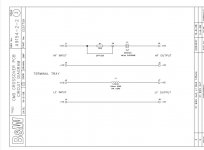Hello friends 🙂
Is it possible to upgrade the crossover for CM5 speaker ? I did not find anything ? thank you
Is it possible to upgrade the crossover for CM5 speaker ? I did not find anything ? thank you
You always start by doing the homework. Service manual here:
B&W Group North America Service & Support - Home
More details here:
Bowers & Wilkins CM5 loudspeaker | Stereophile.com
Minimal crossover is 1.4mH aircoil on 6.5" Kevlar bass, 4.7uF Mundorf capacitor to 1" metal tweeter. Possibly with 0.5R level adjust in series.
I expect you could do something a bit more sophisticated. Often you notch a 6.5" bass at 5kHz to take out some breakup. A higher order tweeter would be feasable too.
Depends how interested you are, and how willing to learn about these things.
B&W Group North America Service & Support - Home
More details here:
Bowers & Wilkins CM5 loudspeaker | Stereophile.com
Minimal crossover is 1.4mH aircoil on 6.5" Kevlar bass, 4.7uF Mundorf capacitor to 1" metal tweeter. Possibly with 0.5R level adjust in series.
I expect you could do something a bit more sophisticated. Often you notch a 6.5" bass at 5kHz to take out some breakup. A higher order tweeter would be feasable too.
Depends how interested you are, and how willing to learn about these things.
From what I recall of my own measurements of the air core in its predecessor (CM1) that inductor gets rather lossy above ~1kHz due to proximity effect. You might be able to ameliorate the 1k-5k apparent 'suck out' in the FR plot with an air core using multiple strands of narrower wire, preserving the DCR.
Last edited:
The drivers in this speaker will be engineered to work effectively with a minimilist crossover by incorporting their own mechanical roll-off slopes.
The result, as described in the review, is excellent detail resolution and transparency.
I would leave the crossover alone as it is a distinct design feature.
The result, as described in the review, is excellent detail resolution and transparency.
I would leave the crossover alone as it is a distinct design feature.
I wish there was an option to buy finish upgraded crossover
my electronic skills is not that good
my electronic skills is not that good
This is diy, my friend. We are willing to tinker and learn new skills.
I did find a nice upgrade on a similar B&W DM601-S3:
B&W Bowers Wilkins DM 601-S3 Crossover Upgrade for Better Midrange Perfoprmance
Rutcho tamed the overly bright tweeter with a simple 3.3R resistor and added a rolloff shunt of 1.8R and 4.7uF to the kevlar bass.
Very good result, IMO.
Not a million miles from one of Lojzek's splendid efforts:
Visaton-Monacor 2 way sealed simple loudspeaker build plans
I did find a nice upgrade on a similar B&W DM601-S3:
B&W Bowers Wilkins DM 601-S3 Crossover Upgrade for Better Midrange Perfoprmance
Rutcho tamed the overly bright tweeter with a simple 3.3R resistor and added a rolloff shunt of 1.8R and 4.7uF to the kevlar bass.
Very good result, IMO.
Not a million miles from one of Lojzek's splendid efforts:
Visaton-Monacor 2 way sealed simple loudspeaker build plans
What do your listening skills tell you is wrong with the present crossover?my electronic skills is not that good
Knowing what we are trying to fix with a crossover upgrade would be most helpful.
What do your listening skills tell you is wrong with the present crossover?
Knowing what we are trying to fix with a crossover upgrade would be most helpful.
Why do you insist on posting common sense ?
You'll never get anywhere in the forum world like that 😀
There's definitely a downside to a single series cap for the tweeter, and that's tweeter excursion. Lynn Olson writes : The Ariel, Part II
All direct-radiators (tweeters, mids, woofers, etc.) have diaphragm excursion that increases with decreasing frequency at a rate of 12dB/octave. (Drivers are constant-acceleration devices.) To prevent the excursion from actually increasing below crossover, you must use at least a 2nd-order (12dB/Octave) crossover ... even this rate simply keeps the excursion constant below the crossover point.
All direct-radiators (tweeters, mids, woofers, etc.) have diaphragm excursion that increases with decreasing frequency at a rate of 12dB/octave. (Drivers are constant-acceleration devices.) To prevent the excursion from actually increasing below crossover, you must use at least a 2nd-order (12dB/Octave) crossover ... even this rate simply keeps the excursion constant below the crossover point.
It may be that the diaphragm excursion problem is avoided in the CM5 because the crossover (natural driver slopes in combination with electrical slopes) is effectively second-order Linkwitz-Riley.
In combination with a crossover frequency of 4kHz, this would result in the tweeter being at least 24dB down at its fundamental frequency of resonance.
There's an interesting discussion on 1st order tweeters here:
1st order tweeters
In combination with a crossover frequency of 4kHz, this would result in the tweeter being at least 24dB down at its fundamental frequency of resonance.
There's an interesting discussion on 1st order tweeters here:
1st order tweeters
Useful thread, thanks. So what I'm getting here is that even though there's no electrical correction shown for the tweeter impedance rising at resonance, potentially there's an acoustic fix in that the tweeter may have a 'Nautilus tube' on its rear which flattens the impedance curve?
- Home
- Loudspeakers
- Multi-Way
- CM5 B&W upgrade crossover

